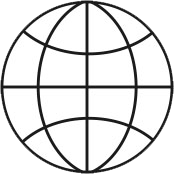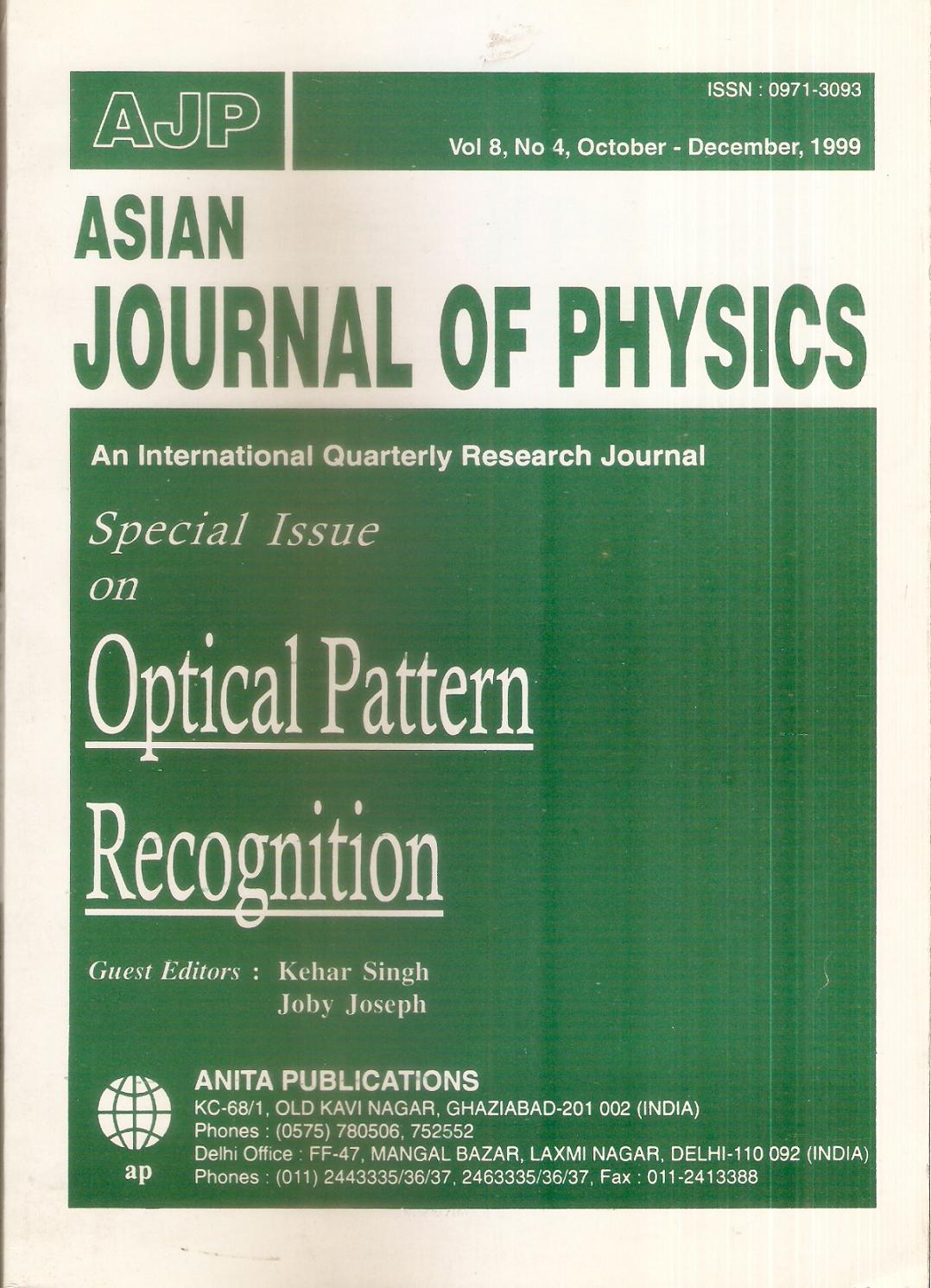
ap

ap
An International Peer Reviewed Research Journal

AJP
SSN : 0971 - 3093
Vol 8, No 4, October - December,
1999
Asian Journal of
Physics
Vol.
8, No 4 (1999) 381-383
Enhancing the discrimination capability of phase only filter
ABDUL AHAD S. AWWAL and HOWARD E MICHEL
Computer Science & Engineering
Wright State University Dayton, Ohio 45435,USA
Electrical and Computer Engineering, University of Massachusetts, Dartmouth
Dartmouth, MA, 02747 USA
___________________________________________________________________________________________________________________________________
This
paper establishes the equivalence of the phase only filter and a
complex-valued neural network, and then shows how neural network
learning can be utilized to enhance the capability of
phase-only-filter based system. Specifically, the capability of
phase only filters in pattern matching tasks is enhanced by using
complex-valued, neural network learning algorithms. By
incorporating the neural network based learning, the recognition
capability of phase only filter under various transformations and
distortions can be enhanced. © Anita Publications. All rights
reserved.
Total
Refs : 18
___________________________________________________________________________________________________________________________________
Asian Journal of Physics Vol 8, No 4 (1999) 385-396
The use of regions of support in the design of filters for optical pattern recognition
M J YZUEL, J CAMPOS, I MORENO*, E AHOUZI and A ATTALEB
Departamento
de Fisica, Universidad Autonoma de Barcelona, 08193 Bellaterra,
Spain
Dept. de Ciencia y Tecnologia de Materiales, Universidad Miguel
Hernandez, 03202 Elche, Spain
___________________________________________________________________________________________________________________________________
In this
work we present numerical simulations and experimental results on
the use of regions of support applied to phase only filters, in
pattern recognition problems. The regions of support indicate the
pixels of the phase-only filter which are blocked, following an
optimization criteria for the correlation intensity distribution.
We present results on the design of regions of support that
optimize the discrimination capability between similar objects. We
apply this technique to the recognition of monochromatic patterns,
and also to the case of colored patterns using a multichannel
correlation procedure. Finally we show experimental results of the
implementation of regions of support using phase-only spatial light
modulators. The implementation based on the addition of linear
phase codes to the pixels belonging to the region of support.
© Anita Publications. All rights
reserved.
Total
Refs : 15
___________________________________________________________________________________________________________________________________
Astan Journal of Physics Vol 8, No 4 (1999) 397-405
Phase-only matched filtering with a bistable spatial-light modulator
YUKIHIRO
ISHII and TAKESHI TAKAHASHI
Department
of Electronics
University of Industrial Technology,
Sagamihara,
4-1-1 Hashimotodai, Sagamihara, Kanagawa
229-1196, Japan
___________________________________________________________________________________________________________________________________
A real-time optical processing system is constructed with an optically addressed bistable spatial light modulator (BSLM) for an input object and a twisted nematic liquid-crystal spatial light modulator for a phase-only filter. In order to improve the pattern discrimination in a phase-only filtering correlator, the use of a phase-encoded input with the BSLM is required. The binarization in phase input can be suppressed the dc component, yielding the high discrimination. Helpful data on how the BSLM can operate the phase-encoded modulator are shown. A phase-only filtering correlator with the BSLM demonstrates high performance in pattern discriminability.© Anita Publications. All rights reserved.
Total
Refs : 26
___________________________________________________________________________________________________________________________________
Asian Journal of Physics Vol 8, No 4 (1999)407-420
Recent advances in composite correlation filter designs
B V K
VIJAYA KUMAR and MAHALANOBIS*
Department
of ECE, Carnegie Mellon University, Pittsburgh, PA 15213,
USA
*Raytheon Missile Systems Company, Tucson, AZ
85750, USA
___________________________________________________________________________________________________________________________________
Several advances in designing composite correlation filters have been made during the last decade. Examples include unconstrained filters, maximum average correlation height (MACH) filters, distance classifier correlation filters (DCCF) and polynomial correlation filters (PCFs). We present a tutorial review of these advanced composite correlation filters designs.© Anita Publications. All rights reserved.
Total
Refs : 11
___________________________________________________________________________________________________________________________________
Asian journal of Physics Vol 8, No 4 (1999)421-429
Rotation invariance considerations in cascaded linear shift invariant processing
STUART
REED and JEREMY COUPLAND
Department
of Mechanical Engineering, Loughborough University, Ashby Road,
Loughborough,
Leicestershire, LEI 1 3TU. United Kingdom.
___________________________________________________________________________________________________________________________________
We perform a study of the in-plane rotation invariance characteristics of the cascaded correlator and compare our results with those of a modified matched spatial filter (MSF), the equal correlation peak synthetic discriminant function (ECP-SDF). The degradation in signal-to-noise ratio as a function of in-plane rotation angle is numerically evaluated by computer simulation for cascaded correlators to demonstrate the effect of training set size. The correlator impulse response of each correlator is formulated by backpropagation and simulated annealing with a training set containing random images generated with an exponential shaped autocorrelation function. We show that the SNR for rotations intermediate to those in the training set improves with an increase in the training set size. However, the SNR of rotations close to those in the training set reduces. It is found that, for the same image space-bandwidth product (SBWP), the cascaded correlator remains rotation invariant over a significantly greater range of rotation than the ECP-SDF. For example, it is necessary to piecewise implement only three cascaded correlators to maintain an SNR greater than 0dB across the rotation range whereas the ECP-SDF system requires approximately 45 piecewise filters to obtain the same result. SNR is degraded to an equivalent level to that of the ECP-SDF over larger rotations intermediate to the training set. This degradation is found to decrease with increased training set size for both systems.© Anita Publications. All rights reserved.
Total
Refs : 17
___________________________________________________________________________________________________________________________________
Asian Journal of Physics Vol 8, No 4 (1999) 485-496
Optical wavelet transform implementations
SAMUEL P KOZAITIS
Division
of Electrical, Computer Science and Engineering
Florida
Institute of Technology,
150
W. University Blvd.,
Melbourne,
Florida 32901
___________________________________________________________________________________________________________________
Wavelet transforms have been shown to have advantages in image analysis, data compression and feature extraction, when compared to other methods. We review the many optical methods that have been proposed or demonstrated to calculate wavelet transforms.
___________________________________________________________________________________________________________________________________
© ANITA PUBLICATIONS
All rights reserved
Designed & Maintained by
Manoj
Kumar